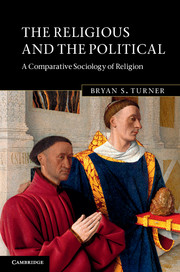Book contents
- Frontmatter
- Contents
- Acknowledgements
- Introduction
- Part I The religious and the political
- Part II State management of religion
- Part III Comparative and historical studies
- 8 Buddhism and the political: the sangha and the state
- 9 Confucianism as state ideology: China
- 10 Religion, state and Japanese exceptionalism: nihonjinron
- 11 State and Turkish secularism: the case of the Diyanet
- Part IV Conclusion
- References
- Index
11 - State and Turkish secularism: the case of the Diyanet
Published online by Cambridge University Press: 05 April 2013
- Frontmatter
- Contents
- Acknowledgements
- Introduction
- Part I The religious and the political
- Part II State management of religion
- Part III Comparative and historical studies
- 8 Buddhism and the political: the sangha and the state
- 9 Confucianism as state ideology: China
- 10 Religion, state and Japanese exceptionalism: nihonjinron
- 11 State and Turkish secularism: the case of the Diyanet
- Part IV Conclusion
- References
- Index
Summary
Introduction
In this chapter we examine the case of Turkey, which has been regarded, in both academic and political circles, as a model of successful secularization from the time of Mustafa Kemal Atatürk. In contesting this common and simplistic assumption, we concentrate on the history and role of the Diyanet, which is, we argue, yet another illustration of the management of religion by the state. As a result we develop an argument against the conventional view of republican Turkey as a deeply and uniformly secular society. Turkish secularism has been considered an interesting case by both academic and political observers, because it represents a ‘working example’ of Muslim secularism. The Ottoman reforms from the early nineteenth century and those of the new Republic were designed to bring about modernization, and eventually Turkey was launched as a secular nation-state on the model of French secularism. Among the various reforms conducted during the Early Republican Period (1923–38) it is possible to consider the regulations and reforms enacted in the early 1920s as building blocks of the secular system. A raft of legislative changes transformed the institutional structures of the Ottoman Empire into the secular arrangements of the Turkish nation-state. An important example of these institutional reforms was the abolition of the existing Ministry of Islamic Law and Charitable Foundations (Şeriye ve Evkaf Vekaleti), which was founded in 1920, and the creation of the Diyanet İşleri Başkanlığı (Directorate of Religious Affairs) in 1924 to manage religious services for the Sunni majority.
- Type
- Chapter
- Information
- The Religious and the PoliticalA Comparative Sociology of Religion, pp. 206 - 224Publisher: Cambridge University PressPrint publication year: 2013
- 7
- Cited by

